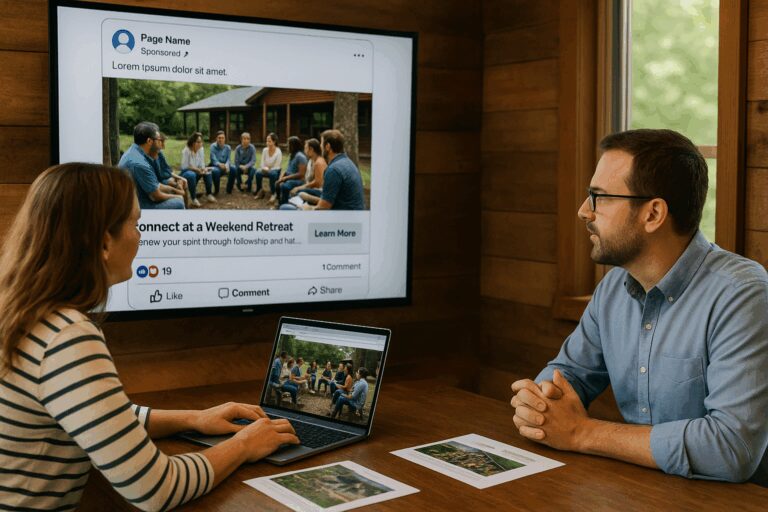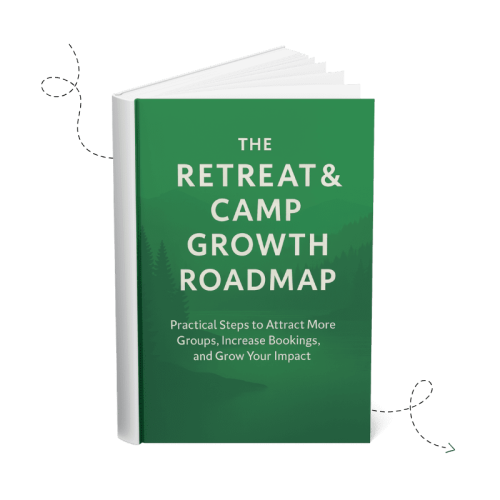Retreat & Camp Growth Roadmap Focus Area: Launch Social Media Ads
Introduction
You’ve likely heard about social media advertising. Maybe you’ve “boosted” a post or heard someone say, “you should try Facebook ads.” But turning that into a real plan—one that helps your retreat center or camp reach new audiences without wasting resources—can feel unclear or intimidating.
This article will give you a clear, strategic understanding of how social media ads can expand your reach, how they differ from what you may have tried before, and how to plan your first campaign with confidence.
Why This Focus Area Matters
Most retreat centers and camps rely heavily on referrals, returning guests, and people who already know them. These are blessings—but they can also become limits. If you only reach people already looking for you, you miss the opportunity to serve others who don’t yet know you exist.
Social media ads help expand your visibility to mission-aligned groups who may not be actively searching for you—but who would value what you offer. This kind of outreach is about more than growth. It’s about stewardship: filling unused capacity, maximizing your impact, and ensuring more people experience your space for rest, renewal, and connection.
Is This an Area You Need to Focus on Right Now?
Ask yourself:
- Are most of your bookings from returning guests or referrals?
- Are you trying to grow midweek or off-season bookings?
- Do you have a new offering (e.g., leadership retreat, marriage getaway) that needs visibility?
- Are you struggling to reach new types of groups or demographics?
- Do your social media posts only reach your current audience?
If you answered “yes” to any of these, this focus area can help you bring greater clarity, alignment, and impact to your outreach.
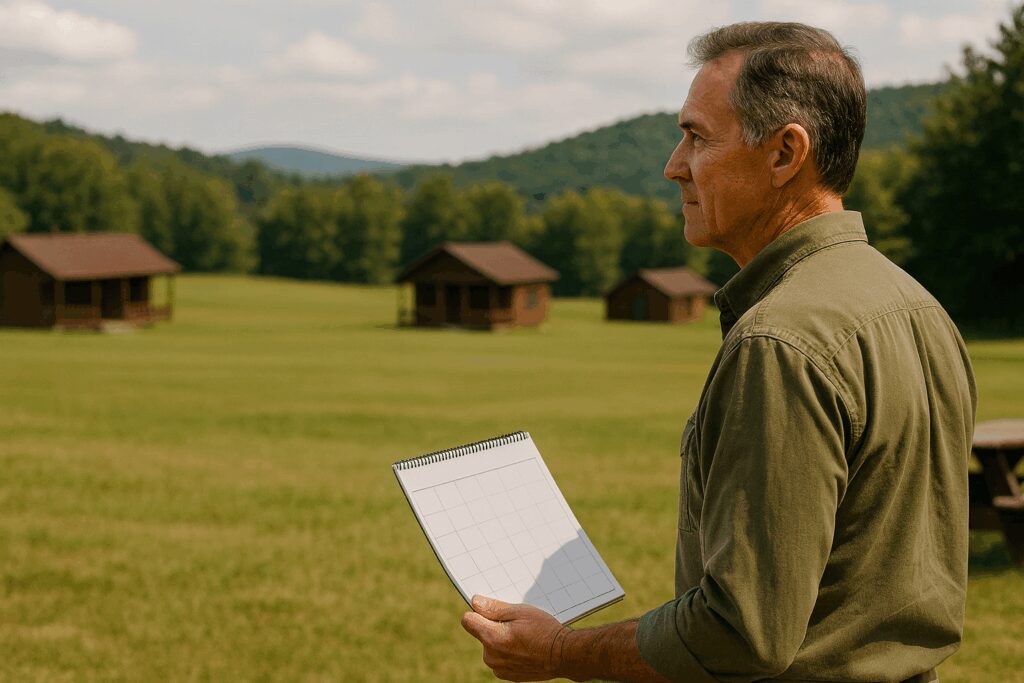
Putting This Focus Area into Practice
Social media ads can feel overwhelming, especially if you’ve never run a campaign before. But with a little guidance, you can use them to introduce your retreat center or camp to people who are aligned with your mission but simply haven’t discovered you yet. Let’s walk through how to do that—step by step.
How Social Media Ads Are Different from Boosted Posts
You may have boosted a Facebook or Instagram post in the past. This feature is designed to get more eyes on something you’ve already shared, and it’s often positioned as a quick way to grow your reach. But boosting a post and running a full ad campaign are not the same thing.
When you boost a post, you’re essentially saying, “Show this to more people like the ones who already follow us.” That can be helpful—but it’s limited. With a real ad campaign, you start from scratch: you choose the exact audience you want to reach, the message you want to share, and the goal you want to accomplish. You’re not just getting more engagement—you’re intentionally reaching new, mission-aligned groups who may never have seen your content before.
In short, boosting helps expand existing content. A campaign helps create new awareness among the right audience.
When Awareness Ads Make Sense
Awareness campaigns are a smart choice when your goal is to grow your visibility—not necessarily to drive immediate bookings. If you’re launching a new program, trying to fill off-season or midweek openings, or hoping to reach groups outside your usual referral network, awareness ads can help you plant seeds that bear fruit over time.
For example, a Christian retreat center developed “Midweek Mini-Retreats” for pastors and church staff. They ran a Facebook ad targeted to ministry leaders within 100 miles. Over several months, they received inquiries from people they had never connected with before—new pastors, regional ministry teams, and small church leaders who hadn’t previously considered hosting a retreat. These relationships continued to grow and eventually became repeat bookings.
Awareness ads are best used when you’re looking to grow visibility, open new relationships, or create interest where none currently exists.
Set the Right Expectations About Timing and Performance
It’s important to approach social media ads with the right mindset. Unlike Google Ads, where someone is actively searching for “Christian camp near me,” social media ads are more like digital billboards. You’re introducing your center to someone for the first time—possibly before they’ve even thought about booking a retreat.
That means the results often take longer to show. Don’t expect a flood of bookings overnight. Instead, look for early signs of traction: people engaging with your content, visiting your website, or watching your video all the way through. These are indicators that your message is reaching the right audience—and laying the foundation for future action.
Set your expectations around long-term value, not immediate outcomes.
Clarify Your Campaign Goals
Before you launch any campaign, you need to be clear on what you’re trying to accomplish. Do you want more people to know your center exists? Do you want them to click through to a retreat information page? Or do you want them to fill out a contact form?
Meta (Facebook/Instagram) offers several campaign objectives to match your goals. For most first-time advertisers focused on awareness, options like “Reach,” “Engagement,” or “Website Traffic” are great starting points. Your goal shapes everything else: your audience, your message, and how success is measured.
The more specific your goal, the easier it becomes to measure success and improve your strategy over time.
Define the Right Audience
Social media advertising allows you to choose the general type of person who will see your ad. This might include youth pastors, church admins, women’s ministry leaders, or teachers—depending on the groups you’re trying to reach.
While you can set interests, job titles, or locations, Meta’s algorithm will still use its own data to decide who within that group is most likely to respond. That’s okay. Focus on targeting by geography and general role or interest, and let the system fine-tune from there.
What matters most is crafting a message that resonates with the kind of group leader you want to reach—and allowing the platform to do what it does best: deliver it.
Choose Your Content Format Wisely
There are several types of ads you can run: image, video, carousel (a series of images), and more. Each has its strengths, and choosing the right format depends on what you’re promoting.
For example, a photo of your retreat lodge might work well as a single-image ad if your goal is to build awareness. If you’re promoting multiple aspects of your facility—like lodging, dining, and recreation—a carousel may be more effective. Short videos (even shot with a phone) can build trust quickly, especially if they show real people, real stories, and real experiences.
Choose a format that showcases your strengths in a way your audience will find inviting and clear.
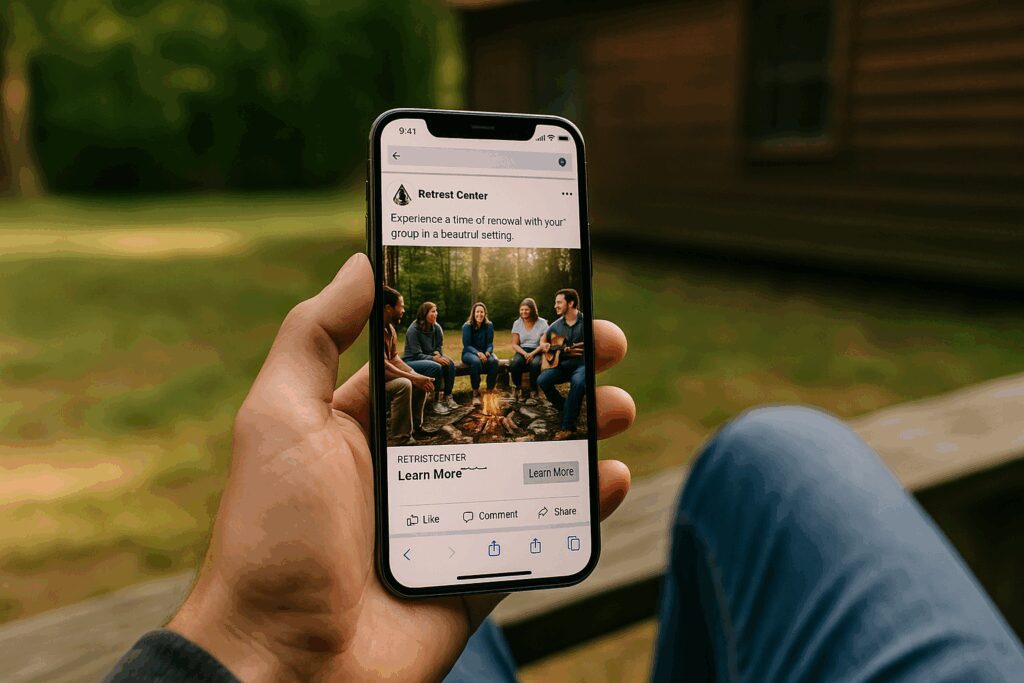
Crafting Ad Creative That Connects
Many people assume the secret to good ads is clever wording or polished design. But the truth is simpler: what resonates most is real content that reflects your mission.
Use language that speaks to transformation. Instead of “Book your retreat today,” try “Your team deserves space to rest and reconnect.” Feature photos of actual guests—not stock images. And if you want to test what works, try running two versions of the same ad with a different photo or headline to see what performs better.
Genuine, mission-driven messaging is almost always more effective than overly polished marketing speak.
Steward Your Budget Strategically
A common misconception is that you need a big budget to see results. In reality, even $5 to $15 per day can make a meaningful impact if your audience is well-defined and your message is strong.
Start small and give the campaign time to learn—at least 2–4 weeks. If you see strong performance (such as steady clicks or video views), you can gradually increase your budget. Avoid making big jumps overnight, as this can throw off the system’s learning phase.
One ad. One audience. One message. That’s often the most effective place to start.
Measure What Matters
When you start running ads, it’s easy to focus on surface-level metrics like likes or shares. While those are encouraging, they don’t tell the full story.
Instead, pay attention to metrics that show interest: how many people saw your ad, how many clicked to your website, or how many watched your video most of the way through. These are signs that your message is reaching the right people—and opening the door to future engagement.
It’s better to have 100 deeply interested people than 1,000 casual likes.
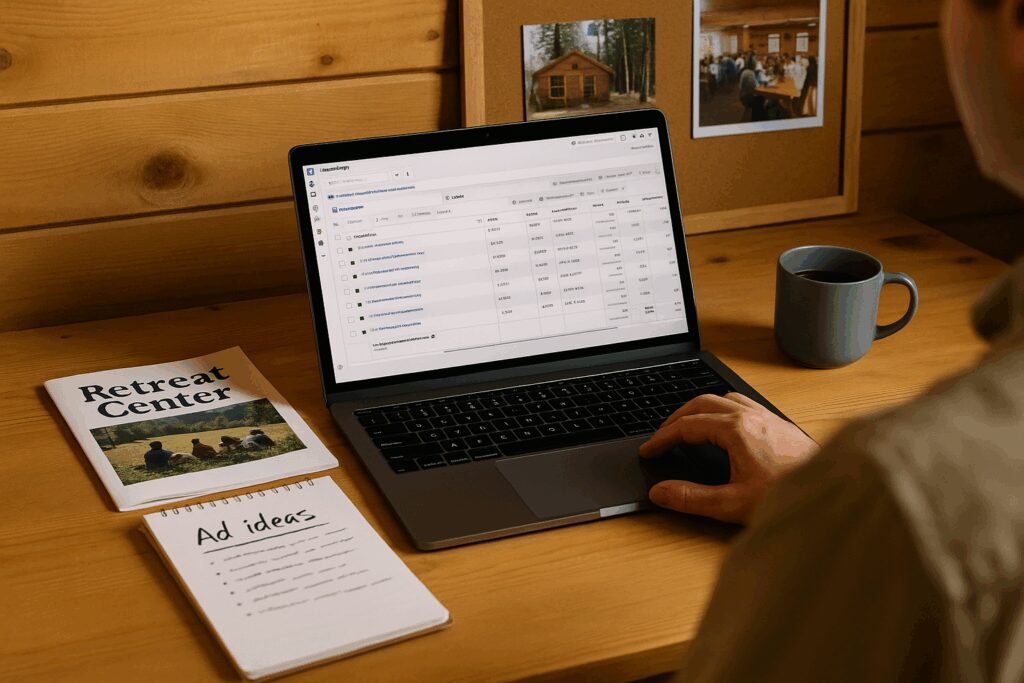
Social Media Ad Campaign Planning Worksheet
If you’re not sure where to begin with Facebook or Instagram ads, this worksheet will help you plan with confidence. Designed specifically for Christian retreat centers and camps, this tool walks you step by step through the most important elements of a successful awareness campaign—so you can reach new, mission-aligned groups with clarity and purpose.
Use this worksheet to:
- Define a clear and specific campaign goal
- Identify and focus your target audience
- Write messaging that speaks to transformation and connection
- Choose the right format and visuals for your ad
- Set a realistic daily budget and schedule
- Identify what success looks like—and how to adjust if needed
📥 Download the Social Media Ad Campaign Planning Worksheet
Whether you’re running your first ad or refining an existing campaign, this worksheet will help you stay grounded in what matters most: reaching the right people with a message that reflects your mission. Start with clarity, and let the results grow from there.
Mini Case Study
A Christian camp had a fully booked retreat calendar but was looking to grow revenue by increasing group activity bookings—especially during shoulder seasons. They had seen great results from Google search ads promoting their zipline tours, but noticed most bookings were coming from out-of-town guests. Despite being a long-standing ministry in the area, local brand awareness was surprisingly low due to their historic focus on group outreach beyond the region.
To address this, they launched a social media brand awareness campaign on Facebook and Instagram targeting both local residents and regional tourists within driving distance. They began with high-quality images and video clips originally developed for a local magazine feature and TV commercial, then later added new content captured by a staff member.
The ads focused on real guests enjoying their zipline tours, using themes like “outdoor adventure” and “the experience of a lifetime.” The results exceeded expectations: they achieved a 16X return on ad spend, meaning they generated $16 in booked revenue for every $1 spent on advertising. The campaign also led to a significant increase in local awareness, social media followers, website traffic, and direct inquiries.
Encouraged by this success, the camp expanded their social media advertising efforts to promote cabin rentals, their high ropes course, and a new escape room experience—each helping them fill unused capacity while reaching new audiences.
Putting It All Together
You don’t need to be a marketing professional to benefit from social media ads. You just need clarity, purpose, and a willingness to start small and learn as you go.
Here are your key takeaways:
- Social ads help you reach aligned groups who aren’t actively searching for you yet.
- One clear message to one defined group beats a broad, complicated campaign.
- Real, mission-focused content builds trust better than anything polished or generic.
- Consistent ads build momentum. Be patient, and focus on learning.
- Start small, steward your spend, and test thoughtfully.
Social media ads are one of the most accessible tools to help expand your ministry’s impact. With the right approach, they become less about technology—and more about inviting people into the experience your retreat center was created to offer.
Ready to Take the Next Step?
Launching your first social ad campaign doesn’t require tech mastery—just clarity, a thoughtful plan, and mission-aligned messaging.
If you found this helpful, here are four great next steps to continue your journey:
🧭 Move to the Next Focus Area: Run Display Ads
Reach more people across the web and stay visible to warm audiences through banner and retargeting ads.
[Read the Run Display Ads Focus Area Article]
📘 Download the Retreat & Camp Growth Roadmap eBook
Get the full 3-stage system we use to help retreat centers and camps grow with clarity and purpose.
[Download the eBook]
🌱 Learn More About How We Help Retreat Centers & Camps
We’re a Christian-owned digital marketing agency that helps retreat centers and camps grow attendance, bookings, and impact through practical strategies rooted in clarity and stewardship.
[See How We Can Help]
🤝 Schedule a Free Discovery Call
Want help applying this to your unique situation? Let’s talk. We’ll explore where you are now, where you want to go, and how to take the next faithful step.
[Book a Discovery Call]
You don’t have to figure this out alone. Let’s build something meaningful—together.
Frequently Asked Questions
1. What’s the difference between boosting a post and running a campaign?
Boosting a post simply increases the reach of content you’ve already published, often to people similar to your followers. A full ad campaign gives you more control over your targeting, message, budget, and results. Campaigns are better suited for reaching new audiences with a specific outcome in mind.
2. How much do we need to spend?
You can start with as little as $5 to $15 per day. What matters most is having a clear goal, a focused audience, and a message that connects. Many retreat centers see solid results with small, steady campaigns.
3. How long should we run a campaign?
Plan to run your campaign for at least 2 to 4 weeks to promote specific events, and ideally for 2-3 months or longer for broader campaigns. It takes time for the algorithm to learn and deliver consistent results. Longer campaigns also give your audience time to engage more than once.
4. What should we promote first?
Start with something specific: a seasonal retreat, a new group offering, or even an event like a leadership weekend. Avoid promoting everything at once. Clear, focused campaigns are more effective and easier to measure.
5. How do we know if it’s working?
Watch for meaningful results: reach, link clicks, time spent on your website, and inquiries that mention seeing your ad. Likes and shares are encouraging, but engagement that shows real interest is more valuable.
6. Can we do this ourselves, or do we need help?
You can absolutely run social media ads on your own using Meta’s Ad Manager. If you feel overwhelmed or want to accelerate your learning, working with a Christian retreat marketing agency can be a great investment.
7. Do we need fancy videos or graphics?
No. Real photos or simple videos taken on a smartphone often outperform polished content. People respond to authenticity—especially when your message speaks to rest, renewal, and community.
8. How are social media ads different from Google Ads?
Google Ads capture people who are already searching for something like “Christian retreat near me.” Social ads introduce your center to people who may not be looking—but are likely to be interested once they learn about you. It’s more about creating awareness than capturing intent.
9. Should ads replace our other outreach?
No. Social media ads are one part of a full marketing strategy. They work best when combined with search engine visibility, email marketing, a clear website, and strong referral relationships.
10. Can AI help with writing ad content?
AI tools can be helpful for brainstorming headlines or drafting copy, but always revise with your center’s voice and mission in mind. Don’t let AI replace the heart of your message—just let it help you get started.
11. What tools should we use to set up and manage our social media ad campaigns?
The primary tool for running Facebook and Instagram ads is Meta Ads Manager. It offers full control over campaign objectives, targeting, budgets, creative content, and reporting. For LinkedIn, the equivalent is LinkedIn Campaign Manager, which is useful for more professional or corporate outreach (like targeting schools, nonprofits, or denominational leaders).
If you’re looking for an easier, more integrated approach, LeadHub CRM is a great fit for retreat centers and camps. It allows you to build, launch, and manage ad campaigns from within your contact and lead management system. It includes built-in conversion tracking, audience list building, and robust reporting tools—all tied to your inquiries and bookings. LeadHub also offers AI-powered tools and campaign templates to help you generate and refine ad copy and images, which is especially helpful if you don’t have a full-time marketing team.
12. Should we run our social media ads ourselves or hire an agency?
It depends on your team’s capacity and comfort level. Many retreat centers and camps successfully manage basic awareness campaigns on their own—especially with the help of tools like Meta Ads Manager or an integrated platform like LeadHub.
That said, even if you run ads in-house, your team should always be involved in shaping the strategy. You know your audience best, and your involvement is essential for setting the right goals, refining the message, and identifying the groups you want to reach.
If you want to grow faster, improve results, or reduce trial-and-error, working with a professional camp marketing agency can make a big difference. Look for one that specializes in high-performance campaigns and has experience with retreat center marketing. The right partner can help you avoid costly missteps, ensure consistent optimization, and align your marketing with your ministry’s heart.

